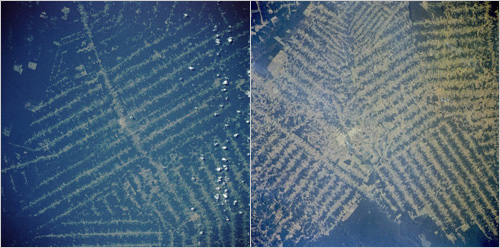Slash & Burn Agriculture
Content Page from Previous Semesters - For Reference Only
Slash & burn agriculture is a form of agriculture that has been practiced in places all around the world for centuries. The process starts with an area of land that is covered with foliage such as trees and shrubs. The foliage is in the way of any would-be agriculture and so it must be cleared before anything can be planted. So, the foliage is slashed: it is cut down. Something then needs to be done with the cut foliage so that it is out of the way. It could be taken off this area of land and put somewhere else, but this is not what is done. Instead, it is burned on the same area of land which it was previously growing in – the same land which is to be planted on. It is burned here because the burning process releases nutrients which then fertilize the soil. So, the slash and burn process successfully clears land for agriculture and introduces fertilizing nutrients into the soil, leaving it in excellent condition to grow crops.
The catch with slash and burn agriculture is that the fertilization from the burning has only a temporary effect. As the crops grow, they uptake the nutrients that were placed into the soil by the burning. The crops in the first growing season have full access to all of the nutrients, but the crops in subsequent growing seasons only have access to whatever nutrients are left over from previous growing seasons. Farmers on this land then face some difficult choices. They might be able to acquire fertilizers to replenish the nutrients in the soil, but this can be expensive, and not everyone has access to fertilizers. They might be able to rotate crops, if different crops will remove different nutrients from the soil and also put other nutrients back into the soil. (For example, grain crops like wheat and maize take nitrogen from the soil, whereas legume crops like beans and peanuts put nitrogen into the soil.) However, this constrains what the farmers are able to grow, and may still be insufficient to sustain high yields. The farmers could simply continue to grow their crops on the land, even while yields decline. But this can impoverish the farmers and their dependents as yields become too low. Finally, the farmers can relocate to new land, repeating the slash and burn process.
In practice, this last option – slashing and burning more land – is often what happens. This can result in vast areas of land being taken up, as farmers go from one area to the next. However, after an area has been left alone for enough time, it will gradually regrows sufficiently that it can be reused for slash and burn agriculture. Thus, it is possible for a slash & burn farmer to within a fixed area of land indefinitely. Each section within that area would go through the same slash/burn/farm/regrows process at staggered intervals. As long as there is enough land per farmer, this form of slash & burn agriculture is sustainable.
In practice today, there very often is not enough land per farmer. This happens when there is a lot of population growth in an area. It means that a given section of land does not have enough time to regrows fully before a farmer needs it again. As a result, more and more land is cleared. This can contribute to major deforestation across broad regions. It can also put farmers and their dependents into poverty, as they lack access to adequate land to grow the food that they depend on. Finally, it can force people out of the farming business. Some of these people may seek alternative employment within the area, and others will migrate. Often these people will migrate to cities, moving into slums and seeking whatever work they can find to get by.
We can now start to see slash & burn agriculture as a human-environment system. All of the different phenomena discussed above, from the soil nutrients to the urban migration, are all interrelated.
Self-check
Draw a system diagram of slash & burn agriculture. You might use a pencil and paper or the Drawing feature in Google Docs.
What do you see as the main components of this type of agriculture? Inputs? Outputs? How do these components relate to one another?
Once you have completed this activity, click below for a pop-up window showing an example diagram. The example diagram is not the only way of drawing the diagram, but it will give you the basic idea of what would be involved.
Click for answer...